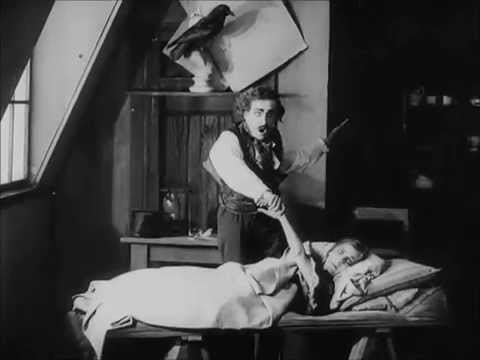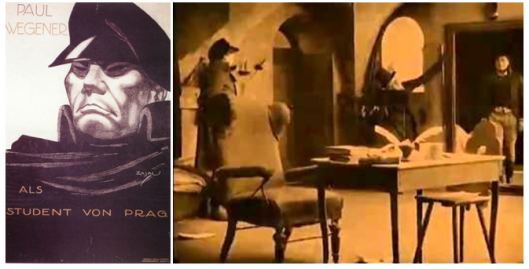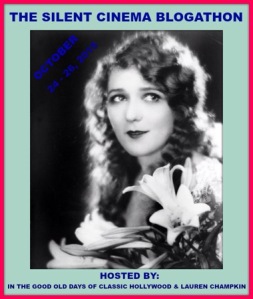Tags
1900s, 1910s, Blogathon, Classic Cinema, Creepy True Story, Crime, Drama, Horror, PoeFest, Racism, Romance
Since it is October, my Poe Fest is in full swing, for those who don’t know, Poe Fest is my annual tradition: every October I read a lot of Edgar Allan Poe, this year I made it a cinematic event.
Cinematic adaptations are frustrating for Poe fans. The divide between the quality of Poe’s original texts and their cinematic treatment is often enormous.
Crystal from In The Good Old Days Of Classic Hollywood and Lauren Champkin are co-hosting The Silent Cinema Blogathon, and this event provides a marvelous opportunity to explore Edgar Allan Poe in the silent cinema.
Thus far, with Poe Fest, I have noticed two trends present in Poe adaptations:
- His biographies always co-mingle his life with his creative works
- Several source stories are present in a single work
My goal is to see where the trends began.
So, I tried to locate as many early Poe films as possible and watch them in chronological order! The quality is a little sketchy, these films may not appeal to the silent aficionado, but they offer striking visual effects and gorgeous images, if you are a fan of visual art, you will appreciate this collection.
D.W. Griffith’s film has the distinction of being described online as “The First Biopic”!
Nevermind the fact that they misspelled his name!
Nevermind the fact that there are no facts in this seven minute short!
Who cares?
This hammy little melodramatic gem reimagines the backstory for Poe’s masterpiece The Raven. A destitute Poe peddles his poem The Raven to get money for food and medicine for his dying wife. Publishers reject the piece and laugh at him. Poe finally sells the poem, but when he returns home his wife dies.
This film is especially significant because it sets an interesting precedent conflating fact and fiction. This motif repeats in all subsequent Poe biopics. The Loves of Edgar Allan Poe (1942) repeats this identical (fictional) event chain.
Der Student von Prag (1913)
Scholar Leo Braudy attributes the film to Poe’s William Wilson while Lotte Eisner attributes it to Chamiso’s Peter Schlemiel and Hoffman’s Das Abenteuer der Sylvester–Nacht.
Der Student Von Prag is directed by Hanns Heinz and Ewers Stellan Rye. The Plot: A young man Balduin is in love with Countess Margit, but his finances prevent his courting her. A strange old man Scapinelli appears, offering Balduin money in exchange for “anything in the room”. The young man blindly signs a contract with the old man and the old man steals Balduin’s reflection. Balduin courts Margit, but the reflection stalks him.
The Poe connection is tenuous, but with striking imagery, well-built tension, and spooky special effects, Der Student von Prag is a delight.
The Avenging Conscience or ‘Thou Shalt Not Kill’ (1914)
The Avenging Conscious is another D.W. Griffith film. Often ascribed as “The First American Horror Film”, it is based on Annabel Lee (an ill-fated love) and The Tell-Tale Heart (a murderous confession). It borrows thematic elements from The Cask of Amontillado, The Bells, and The Black Cat.
The Plot: “A Young Man” (unnamed characters) falls in love with “The Sweetheart”, however, his uncle objects to the match, and the lovers part. While mourning his broken heart, the young man remedies his situation by killing the uncle and stuffs the body in the fireplace. A handyman “The Italian” witnesses the event, and quickly starts a blackmail scheme. The local police investigate. The uncle haunts the young man. The young man is sent to a sanitarium, temporarily. When he returns overcome with grief, he has a religious breakdown, complete with visions of Jesus, Moses, and Devils. Meanwhile, the sweetheart throws herself into the sea.
While the story sounds fabulous in theory, the movie is quite dull.
The nephew is too old for such extreme financial dependence from his uncle. Their house is too small to believe the young man is a gentleman, having no profession. If he leaves the sweetheart so readily, I doubt his devotions, and I question his motive. If he is not killing the uncle to marry the sweetheart then why does he kill his uncle? If he is killing the uncle to marry the sweetheart then why doesn’t he go after her once he is independent? Rather than explain or justify the young man’s motives, we get unnecessary nonsense!
We have an overlong side story about a maid and a grocer, which does not add to the main plot. Then we have random imagery from A Midsummer Night’s Dream where a clumsy Titania “dances” for a bored Oberon.
Oberon, I feel your pain.
If the movie weren’t long enough, additional minutes are wasted for a creepy hairy-legged Pan and an infinite stream of fairy children coming out of a hole in a tree. These children cannot stay in character and they do not understand their blocking.
There are only two plausible explanations:
- Someone wants their kids in the film
- The film contract stipulates “47 fairy children must crawl through a tree!”
Okay, maybe there was like seven or eight kids.
Like many Poe adaptations, The Avenging Conscious is not “Poe-Enough”.
Smoke machines and dancing skeletons mark the height of horror effects. In other words, it is as horrifying as a second-grade classroom Halloween party. Wait a minute, no. Peter Redmond was in my second-grade class, he flipped his eyelids inside out and shot milk through his nose to make me scream on purpose! That was way more horrifying than this film. The whole eyelid-milk thing still freaks me out, when I remember it. So this film was less horrifying than my second-grade class Halloween party.
Back to the film: to add insult to injury, The Avenging Conscious does a full A Christmas Carol repentance/it was all a dream/”let’s wrap it up in a neat little happy ending” type ending.
This snoozefest hardly deserves the title “The First American Horror Film”, but the film deserves examination as it sets a precedent in Cinematic Poe. Like many subsequent Poe adaptations, this film does not stick to one Poe story it borrows from multiple Poe sources.
It took four attempts to complete the film, there is a horrible selection of online versions, it took a day and a half to locate a decent version. Here you go:
The Raven (1915)
The Raven is the last silent film for me. Not because I lost interest, but because I multitask when I watch movies and silent movies require my undivided attention.
This film disguises itself as a Poe biography, it is a diatribe of teetotaler propaganda and a cautionary tale against alcohol consumption.
This dry (pun intended) slander suggests that alcohol is the root of all evil, while Poe is in a drunken stupor the word “WINE” appears on a rock, and skulls appear in his wine glass.
I am not a big drinker, but I would pay serious cash for magic skull wine glasses. In fact, if I had those glasses, I am certain I would drink much more wine just to see the skulls! So much for their anti-drinking imagery, right? Clearly a product of the pre-prohibition era, this film is the most unresearched pile of dribble I have ever encountered in my life. Let me clarify something for anyone who sees this film, Edgar Allan Poe was not a slave owner.
In all fairness, I understand this film is a fragment, but it was not for me.
This film is available through Fandor.
Conclusion
While I have only examined a small sample of silent Poe films, the major trends of mingling fact and fiction and multiple Poe sources are present in the earliest cinematic adaptations.
The two trends must either pre-date cinematic adaptation or these films represent the origin of such practices.
Whether these films are the originators or yet another example in a long line of prior adaptations remains unexplored by this Poe fan. But viewing these silent films raises other questions. Why is it so difficult for a filmmaker to accurately represent Poe’s life, or focus on one creative work?
While these larger questions are not ideal for a short blog post, it does make one think.
How does silent Poe measure up to Talkies?
The silents eliminate the bad dialogue ever-present in the Roger Corman-Poe films, which are the best known Poe adaptations. In my opinion, the silent films lack humor, Corman’s Poe films, despite their shortcomings got Poe’s humor.
I prefer the talkies, even though the silents are far more picturesque.
Visit Crystal from In The Good Old Days Of Classic Hollywood and Lauren Champkin and experience the full The Silent Cinema Blogathon.
Ciao for Now, Dearies!
Resources
Braudy, Leo. The World in a Frame: What We See in Films. Garden City, NY: Anchor, 1976. Print.
Eisner, Lotte H. The Haunted Screen: Expressionism in the German Cinema and the Influence of Max Reinhardt. Berkeley: U of California, 1969. Print.
Hayes, Kevin J. The Cambridge Companion to Edgar Allan Poe. Cambridge: Cambridge UP, 2002. Print.
Jesionowski, Joyce E. Thinking in Pictures: Dramatic Structure in D.W. Griffith’s Biograph Films. Berkeley: U of California, 1987. Print.







Pingback: THE SILENT CINEMA BLOGATHON HAS NOW ARRIVED | In The Good Old Days Of Classic Hollywood.
Very interesting. I had just dug out my Poe for some pleasant October reading (!). It hadn’t occurred to me that he had been adapted in this era or that they may have originated some of the misconceptions.
LikeLiked by 1 person
Apparently, there were several massive Poe waves, the earliest 1909 were planned for the centennial of his birth! The films are fascinating
LikeLike
Ooh got cut off
What was going to say is there are a lot more silent Poe’s like at least 15 films, they are fun 😉
enjoy your Poe reading!
Summer
LikeLike
That was fun. I didn’t know that The Student of Prague could have been associated with “William Wilson.” My favorite silent Poe adaption is the 1928 surrealist “Fall of the House of Usher” by Watson and Melville. It captures the spirit of madness in the story.
LikeLiked by 1 person
Thanks, I am glad you enjoyed it!
I am inclined to say the student is not Poe at all, the connection is questionable but I have massive respect for Braudy, so I am willing to consider his opinions 😉.
Thanks for the Usher tip, it is high on my list!
-Summer
LikeLike
Loved your review, especially your skewering of the 1914 film. Will be back to watch later, after reading the other entries. I’m being honest when I say I cannot wait!
LikeLiked by 1 person
They are all fun, if you see them, let me know what you think 😉
LikeLike
Pingback: THE SILENT CINEMA BLOGATHON: A BIG THANK YOU TO ALL PARTICIPANTS | In The Good Old Days Of Classic Hollywood.
Another fabulous post coming from the one and only Summer!
I’m more familiar with the Corman films, but silent adaptations of Poe seem like a good thing… Almost. Too bad Griffith messes some things up here and there in his attempts. I believe Poe is such an interesting character himself, silent filmmakers didn’t even know where to start telling his life story!
Don’t forget to read my contribution to the blogathon! 🙂
Kisses!
Le
http://www.criticaretro.blogspot.com
LikeLiked by 1 person
Hi Le! The films are fun, but they take themselves too seriously, Poe had a marvelously macabre sense of humor. 😉
But the silents are lovely, ideal for people with artistic sensibilities.
-Summer
LikeLike
Ah, The Avenging Conscience! I quite like the film myself, although I was hoping for a little less relationship intrigue and more skeletons (I really, really like that skeleton). Part of its shortcomings can probably be chalked up to being produced in a short amount of time. Walthall did a nice job in his role, I thought–gothic drama was a nice fit for him.
LikeLiked by 1 person
Hi Lea, the Skelton was the best part of the film, skeleton action always improves a film 😜. honestly The Avenging Conscience was not awful, it just lacked an Edgar Allan Poe quality.
The problem was I had pre-researched the film and expected an adaptation of The Tell-Tale heart. Had I not expected that, I am certain my opinion would be higher, but I was really in the mood for a macabre melodrama and lines like “Behold! the Beating of the hideous heart!”
-Summer
LikeLiked by 1 person
Fair enough! I remember looking for more of that when I watched this the first time, myself.
LikeLiked by 1 person
I love Poe and silent film (so creepy!) – love the Poefest thing.
LikeLiked by 1 person
Thanks, Poe is one of those things I totally geek out about!
LikeLike
Summer
If you’d like fleeting humour try Castleton Knight’s Prelude for Rachmaninoff,an adaptation of the Premature Burial , a little gem. Also, Griffith’s The Sealed Room is indebted to Poe and actually quite chilling.
LikeLiked by 1 person
Hi David, Thanks for the hot tip, I will check both out! Ciao for now, Summer
LikeLike